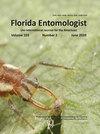Abundance of Tended and Non-Tended Dalbulus Leafhoppers (Hemiptera: Cicadellidae) and their Parasitoids within the Gamagrass Tripsacum Habitat
IF 1.2
4区 农林科学
Q3 ENTOMOLOGY
引用次数: 0
Abstract
Abstract The present study evaluated the abundance of tended and non-tended Dalbulus DeLong (Hemiptera: Cicadellidae) sp. leafhoppers and their parasitoids. A field study was conducted in the gamagrass Tripsacum dactyloides (L.) L. (Poaceae) habitat, where the mutualistic association between the leafhopper Dalbulus quinquenotatus DeLong & Nault (Hemiptera: Cicadellidae) and its tending ant Brachymyrmex obscurior (Forel) (Hymenoptera: Formicidae) occurs. Yellow sticky card traps were used to determine the abundance of Dalbulus leafhoppers and their parasitoids in this habitat. The results showed that D. quinquenotatus was the most abundant leafhopper, whereas Dalbulus gelbus DeLong and the corn leafhopper Dalbulus maidis (DeLong) (both Hemiptera: Cicadellidae), both non-tended species, were least abundant. Three egg parasitoid wasp species were identified: Anagrus naulti Triapitsyn & Moya-Raygoza (Hymenoptera: Mymaridae), which was the most abundant of the trapped parasitoids, and Paracentrobia Howard sp., and Pseudoligosita Girault sp. (both Hymenoptera: Trichogrammatidae). The parasitoids that inhabit the wild Tripsacum habitat are important to conserve due to their potential as biological control agents against corn leafhopper pests. Resumen En este estudio se evaluó la abundancia de atendidas y no atendidas chicharritas del genero Dalbulus y sus parasitoides. Un trabajo de campo fue conducido en el hábitat de Tripsacum dactyloides, donde la asociación de mutualismo entre la chicharrita Dalbulus quinquenotatus Delong & Nault (Hemiptera: Cicadellidae) y sus hormigas Brachymyrmex obscurior (Forel) (Hymenoptera: Formicidae) ocurre. Trampas amarillas pegajosas fueron usadas para determinar la abundancia de Dalbulus y sus parasitoides en este hábitat. Los resultados mostraron que la chicharrita D. quinquenotatus fue la más abundante, mientras que Dalbulus gelbus Delong y la chicharrita del maíz D. maidis (Delong), ambas no atendidas, fueron menos abundantes. Tres especies de avispas parasitoides de huevos fueron identificados: Anagrus naulti Triapitsyn & Moya-Raygoza (Hymenoptera: Mymaridae), la cual fue la más abundante de los parasitoides colectados, y Paracentrobia sp., and Pseudoligosita sp. (ambos Hymenoptera: Trichogrammatidae). Los parasitoides que habitan en el hábitat natural de Tripsacum son importante consérvalos debido a su potencial como agentes de control biológico contra chicharritas plagas del maíz.甘草生境中有照料和无照料的飞蛾叶蝉及其寄生蜂的丰度
摘要本研究评估了有倾向和无倾向的黄鳍金枪鱼(半翅目:叶蝉科)sp.叶蝉及其寄生虫的丰度。在Gamagrass Tripsacum Dactyloides(L.)L.(禾本科)栖息地进行了一项实地研究,在那里,Dalbulus quincenotatus delong&Nault叶蝉(半翅目:叶蝉科)与其倾向的黑暗短吻蚁(Forel)(膜翅目:蚁科)之间存在互惠关系。黄粘卡陷阱用于确定该栖息地中黄豆叶蝉及其寄生虫的丰度。结果表明,D.quinkenotatus是叶蝉最丰富的,而Dalbulus gelbus delong和Corn Leafhopper Dalbulus maidis(Delong)(均为半翅目:叶蝉科)都是非倾向性物种,丰度最低。确定了三种卵寄生黄蜂物种:Anagrus naulti triapitsyn&Moya-Raygoza(膜翅目:Mymaridae),这是陷阱寄生蜂中最丰富的一种,以及副中心恐惧症Howard sp.和假寡食症Girault sp.(两种膜翅目:赤眼蜂科)。居住在野生雷公藤栖息地的寄生虫很重要,因为它们有可能成为防治玉米叶蝉害虫的生物控制剂。摘要在这项研究中,评估了Dalbulus属及其寄生蜂的护理和未护理chicharritas的丰度。在Tripsacum Dactyloides栖息地进行了一项实地研究,在那里,Dalbulus quincenotatus delong&Nault(半翅目:叶蝉科)与其短吻蚁(Forel)(膜翅目:蚁科)之间存在互惠关系。粘性黄色陷阱被用来确定该栖息地中黄檀及其寄生蜂的丰度。结果表明,Chicharrita d.quinkenotatus最丰富,而Dalbulus gelbus delong和玉米Chicharrita d.maidis(delong)都不受关注,数量较少。鉴定了三种卵寄生蜂:Anagrus naulti triapitsyn&Moya-Raygoza(膜翅目:Mymaridae),这是收集到的寄生蜂中最丰富的一种,以及副熵病sp.和假寡食症sp.(两种膜翅目:赤眼蜂科)。居住在Tripsacum自然栖息地的寄生蜂很重要,因为它们有可能作为生物控制剂来对抗玉米害虫。
本文章由计算机程序翻译,如有差异,请以英文原文为准。
求助全文
约1分钟内获得全文
求助全文
来源期刊

Florida Entomologist
生物-昆虫学
CiteScore
2.10
自引率
7.10%
发文量
44
审稿时长
3 months
期刊介绍:
Florida Entomologist is the official journal of the Florida Entomological Society. Volumes 1-3 were published under the name The Florida Buggist. The Florida Entomological Society still produces the traditionally printed version of Florida Entomologist, but you can also view, search, or print any article published since June 1917 by accessing online files. Web access is made possible by the Society’s electronic publication project begun in 1993
 求助内容:
求助内容: 应助结果提醒方式:
应助结果提醒方式:


